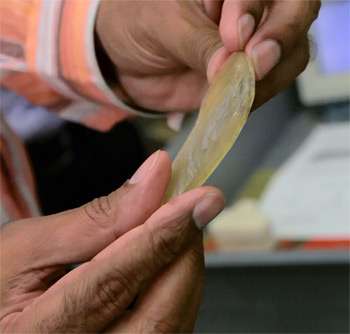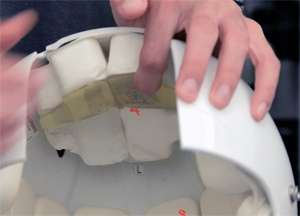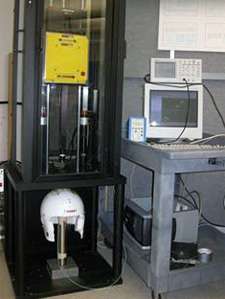Making football helmets safer to prevent concussions

As a sports fan with expertise in biomechanical engineering, UCLA professor Vijay Gupta marvels at the efficient, effective way the human body is built.
For example, the human head—which encases a three-pound brain suspended in cerebral-spinal fluid in the hard shell of the skull—is what the research engineer describes as "the best shock-absorbing system you could ever design." But it wasn't designed to withstand the shockwaves resulting from a collision with a 250-pound football player wearing a helmet.
So Gupta is applying his expertise in materials science, mechanical engineering and bioengineering to protect the brain from the forces that cause concussions and traumatic brain injury. He's created a polymer that could diminish the force of helmet-to-helmet hits on a football field or shockwaves from explosive devices on a battlefield. To test out his material, Gupta uses lasers and a grandfather-clock-sized hammering machine.
"If I cut down the level of force with my material, that's going to help concussion reduction," Gupta said. A professor of mechanical and aerospace engineering, bioengineering, and materials science and engineering who grew up in India, Gupta is also sports fan who developed an interest in American football while living with sports fanatics during his graduate studies at Massachusetts Institute of Technology.
As concussions have become a much-discussed topic among athletes, sports fans, officials with various sports leagues and parents, Gupta thought to himself, "As someone who likes football and as a biomechanical engineer, what can I do?"
He started by building on previously published research about brain injuries from the 1960s and, more recently, a study sponsored by the NFL. To determine concussion probabilities for football players, researchers examined game videos of hits, some that resulted in concussions and others that did not lead to brain injury. Taking into account the size of the players and measuring how fast they were running, researchers were able calculate the G-force of the football hits and establish a concussion probability curve.

"Above 90 Gs, you have an almost 90 percent probability of a concussion," Gupta said.
To improve on the shock-absorbing ability of the standard football helmet without radically changing its design, Gupta added a 2-millimeter-thick wafer (about the thickness of a nickel) of a firm, but flexible polymer he devised to reinforce the helmet's foam padding. Then Gupta and his students Matt Timsit, Ryan Crum and Jason Citron used the hammering machine to drop a weight on top of the helmet from a specified height to generate a range of G-forces. They measured the force felt by using a sensor.
The special polymer that Gupta has produced in his lab in the Henry Samueli School of Engineering and Applied Science, with his students Ninh Le and George Youssef, has yielded promising results. They've tried different mixes of the polymer to alter its rigidity and viscoelasticity, as well as varying its thickness and where they placed the polymer layers in the helmets. Gupta and his team have been able to achieve up to a 25 percent reduction in the force a person would feel. This translates to a similar reduction in the probability of getting a concussion.
"This is a remarkable reduction given that we are adding such a small amount of material that essentially leaves the current helmet unaltered," Gupta said. If the helmet is altered too much, the concern is that it might affect how players are forced to play and they might not want to wear it.
Gupta noted that improvement comes only when the shock-absorbing polymer is placed inside the helmet on the foam padding. When the polymer is placed outside the helmet it actually increases the impact force.
In addition to helping prevent injuries in football, Gupta's also testing how well his material would absorb shock for runners. He said that tests have shown a significant reduction in the shock by placing just a 1.5-mm-thick layer of the material below the sock liner. Gupta estimates that runners who run five to 10 miles per week could increase the life of their knee cartilage life by 10 to 15 years (depending upon the age of the runners). Gupta said that's a similar shock absorption as insoles you can buy now, but his polymer is just one-tenth as thick.

Gupta started working with this polymer about eight years on a project for the U.S. Navy, which needed a substance that would bond steel and a composite material in a new ship design. The substance he created ended up being stronger than the composite material he was joining with the steel. These joints forged by his material proved they could withstand shocks from explosions and that's when he realized the shock absorbing potential of his polymer for protection against explosions.
Not surprisingly then in addition to helping prevent injuries in athletics, Gupta sees possible military applications for the polymer. Soldiers are subjected to powerful shockwaves from explosive blasts on the battlefield, and Gupta thinks adding his polymer to military helmets could help diminish those effects and reduce traumatic brain injuries.
When shockwaves from an explosive hit the brain, the impact lasts far less than a football collision, so Gupta uses lasers to replicate such shocks. "An athlete feels the force of helmet-to-helmet [hits] over 10 to 30 milliseconds. That's several thousandths of a second," Gupta said. "The shockwaves of an explosive device last for just a millionth of a second but has tremendous force."
Impacts, whether from hits by a hard object or high-speed shockwaves, are one of two causes of concussions and traumatic brain injury. The impact literally causes a stress wave to pulse through the brain, hit the other side of the skull and rebound back through the brain. These reverberations cause pushing and pulling forces that tear apart tissue, like blood vessels and neurons, Gupta said. Concussions can also result from the head being violently shaken, but there's no materials technology to lessen the traumatic effects of that, Gupta said.
The brain injuries that result from concussions can also be difficult to diagnose, especially if the force of the impact is lower. "You get hit, and the shockwave goes in and comes back, but you don't have enough intensity to cause visible damage in an MRI," Gupta said. The repeated effects of low intensity shockwaves on the body remains a debated topic, and further research is needed to settle this conclusively, Gupta said.














